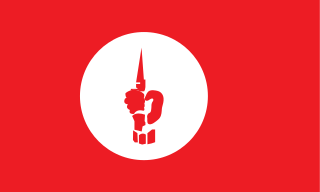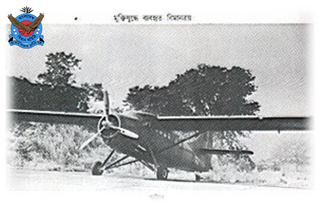
The Bangladesh Armed Forces are the combined military forces of the People's Republic of Bangladesh. It consists of the three uniformed military services: the Bangladesh Army, the Bangladesh Navy and the Bangladesh Air Force. The Armed Forces are under the jurisdiction of Ministry of Defence of the Government of Bangladesh, and is directly administered by the Armed Forces Division of the Prime Minister's Office. The President of Bangladesh serves as the Commander-in-Chief of the Bangladesh Armed Forces. It has the third-largest defence budget in South Asia and according to the Global Firepower index it is the third most powerful military force in South Asia. Border Guard Bangladesh and Bangladesh Coast Guard are under the jurisdiction of the Ministry of Home Affairs during peacetime, but during wartime they fall under the command of Bangladesh Army and Bangladesh Navy respectively.

The Bangladesh Air Force (BAF) is the aerial warfare branch of the Bangladesh Armed Forces. The air force is primarily responsible for air defence of Bangladesh's sovereign territory as well as providing air support to the Bangladesh Army and Bangladesh Navy. Furthermore, the BAF has a territorial role in providing tactical and strategic air transport and logistics capability for the country.
Muhammad Ataul Gani Osmani, was a Bengali military leader. Osmani's career spanned five decades, beginning with service in the British Indian Army in 1939. He fought in the Burma Campaign during World War II. After the partition of India in 1947, he joined the Pakistan Army and served in the East Bengal Regiment, retiring as a colonel in 1967. Osmani joined the Provisional Government of Bangladesh in 1971 as the commander-in-chief of the nascent Bangladesh Forces. Regarded as the founder of the Bangladesh Armed Forces, Osmani retired as a four-star general from the Bangladesh Army in 1972.

Flight Lieutenant Matiur Rahman BS was a Bengali officer of the Pakistan Air Force from East Pakistan and a recipient of Bir Sreshtho, Bangladesh's highest military gallantry award for his actions during the Liberation War of Bangladesh.
Abu Saleh Mohammad NasimBir Bikrom is a former Chief of Army Staff of the Bangladesh Army. In 1996, he attempted a military coup of the caretaker government which was preparing for general elections. After failure of the coup in 1996, he was arrested, placed under house arrest, and subsequently dismissed from service. That year, the Awami League was elected to power in the government. It reverted Nasim's dismissal from the military and later provided him with an honorable discharge.

Air Chief Marshal Pratap Chandra Lal, DFC was the Chief of Air Staff (CAS) of the Indian Air Force (IAF) during the Indo-Pakistani War of 1971. He served in the IAF from 1939 until his retirement in 1973. He was the CAS at the time of Operation Chengiz Khan, the preemptive strikes that were carried out by the Pakistan Air Force (PAF) that marked the formal initiation of hostilities of the war.
Muhammed Abul ManzurBU was a Bangladeshi military officer who commanded the Bangladesh Forces operations in Sector 8 during the Bangladesh Liberation War against Pakistan in 1971. He was allegedly involved in the assassination of the then-President of Bangladesh, Ziaur Rahman. The erstwhile Chief of Army Staff and alleged mastermind of Rahman's assassination, Hussein Muhammad Ershad, had put a standing shoot-to-kill order on Manzur's life—he was killed shortly after being captured at the border. About a year later, Ershad initiated a bloodless coup d'état and took over the Central Government, holding power until 1990.

Operation Jackpot was a codename for three operations undertaken by Bengali Mukti Bahini in former East Pakistan against the Federation of Pakistan at the climax of the Bangladesh Liberation War.
Shafaat Jamil, Bir Bikrom was a Bangladesh Army colonel. He was the commanding officer of the 3rd East Bengal Regiment of Z Force Brigade in Sector 11 of Bangladesh Forces during the War of Bangladesh Independence in 1971. He was among the first Bengali officers who rebelled against the Pakistani Army in the 1971 Liberation War of Bangladesh and later fought in 11 sector and in Sylhet sector.
1971 (MCMLXXI) was a common year starting on Friday of the Gregorian calendar, the 1971st year of the Common Era (CE) and Anno Domini (AD) designations, the 971st year of the 2nd millennium, the 71st year of the 20th century, and the 2nd year of the 1970s decade.

Air Vice Marshal (Retd.) Abdul Karim Khandker, Bir Uttom is a former planning minister of the Government of Bangladesh. He is a retired diplomat and was the Deputy Chief of Staff of the Bangladesh Armed Forces during the Bangladesh Liberation War, He was also the first Chief of Air Staff (Bangladesh) get the appointment immediately after the independence of Bangladesh in 1972.
Air Chief Marshal Parvaiz Mehdi QureshiNI(M) HI(M) SI(M) SBt best known as PQ Mehdi, is a retired four-star air officer and former fighter pilot who served as the eighth Chief of Air Staff (CAS) of the Pakistan Air Force from 1997 until his retirement in 2000.

The Mukti Bahini, also known as the Bangladesh Forces, was the guerrilla resistance movement consisting of the Bangladeshi military, paramilitary and civilians during the Bangladesh Liberation War that transformed East Pakistan into Bangladesh in 1971. They were initially called the Mukti Fauj.
Z Force, also known as Tura Brigade, was the first military brigade of Bangladesh Forces formed during the Liberation War of Bangladesh in 1971 under Major Ziaur Rahman along with the consent of the revolutionary government of Bangladesh in exile. The brigade was formed with the 1st, 3rd and 8th Battalion of East Bengal Regiment on 7 July 1971. It is the first ever complete brigade formed during the Liberation War of Bangladesh in 1971.
Air Chief Marshal Satish Kumar Sareen, PVSM, AVSM, VM, ADC was the Chief of Air Staff of Indian Air Force from 31 December 1995 till 31 December 1998.
Martyr Lt. Anwar Hossain was a Bangladesh Army officer who fought in the Bangladesh Liberation war. He was killed in the war and posthumously awarded Bir Uttom, the second highest gallantry award in Bangladesh.

Kilo Flight was the code name for the Mukti Bahini combat aviation formation during the Bangladesh Liberation War in 1971. It consisted of one DHC-3 Otter plane and one Alouette III helicopter, both carrying rocket pods and machine guns for launching hit-and-run attacks on Pakistani targets, and one DC-3 Dakota for logistical missions. 9 Bengali pilots and 58 ex PAF personnel formed the unit under the command of Group Captain A. K. Khandker in September 1971. The aircraft were supplied by Indian Authorities and the formation was led by Squadron Leader Sultan Mahmud under the operational control of IAF base Jorhat. The unit started training in October 1971 at Dimapur in Nagaland, and this unit was the first to launch airstrikes on Pakistani targets in East Pakistan on December 4, 1971, by attacking oil depots at Narayanganj and Chittagong. In total the unit flew 90 sorties and 40 combat missions between December 4 and 16, 1971. After the war, this unit formed the core of the nascent Bangladesh Air Force.

Lieutenant Colonel (Retd.) Quazi Sazzad Ali Zahir is a veteran of the Bangladesh Liberation War. The Bangladesh government awarded him the Bir Protik gallantary award for his bravery in the war. He was conferred with the Independence Award, Bangladesh's highest civilian in 2013 and India's fourth highest civilian award the Padma Shri on November 9, 2021.
Mohammad Ziauddin, BUT is a retired Bangladeshi military officer, who was the Commanding Officer of the 1st East Bengal Regiment during the Bangladesh Liberation War. He was awarded the Bir Uttom, the country's second highest gallantry award for his outstanding bravery in the Liberation War. His certificate number was 22.








